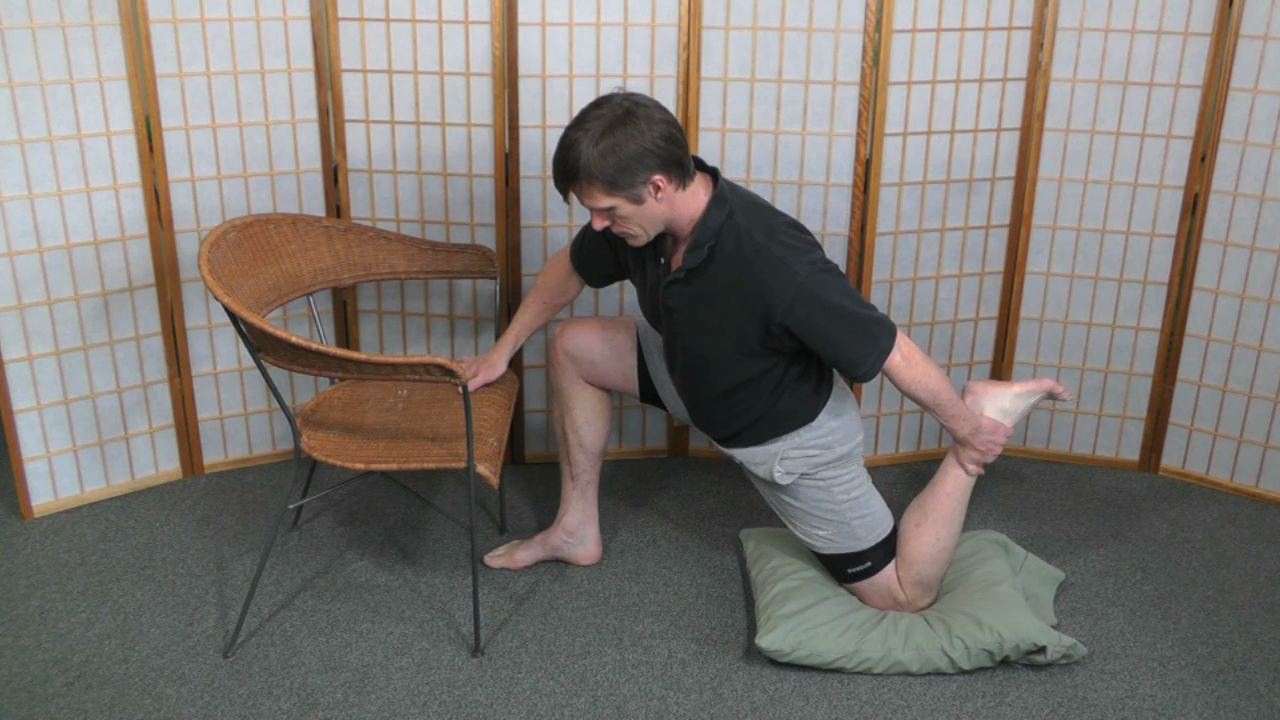Leg Stretches for
Lower Back Pain Relief

Leg stretches are an essential component of lower back health and comfort.
When the muscles of the legs become tight and short (as often happens as a consequence of sitting for long periods), they can fix the position of the pelvis preventing free and easy movement.
When the pelvis is in a fixed position the lower back can become strained as it tries to compensate during movement.
Quadriceps Leg Stretches
The quadriceps are too often ignored or given too little attention in stretching routines. But it is vital that this muscle group is regularly lengthened.
The rectus femoris, in particular, needs to be be stretched often so that it doesn't pull the pelvis on that side into an anterior rotation.
But also the outer and inner quadriceps groups (vastus lateralis and vastus medialis) can contribute to hip tightness when not stretched regularly. And hip tightness can contribute to back pain.
Goal - To lengthen the quadriceps muscles (the front of the upper thight) so that they do not pull the pelvis into an anterior torque which can strain in the lower back.
Quadriceps Stretch
Leg Stretches for the Hamstrings
To insure comfort of the lower back and to prevent the progression of sciatica symptoms the hamstrings must be regularly stretched out. Those who occupy a sitting position for much of the day are especially prone to tight, short hamstrings. Tight hamstrings, like tight adductors, can exert a powerful immobilizing affect on the pelvis which puts strain on the lower back.
Goal - To lengthen the hamstring muscles so that they are not immobilizing the pelvis and thus exerting strain on the lower back.
Basic Hamstrings Stretch
Intermediate-Advanced Hamstrings Stretch (9 min)
Leg Stretches for the Hip Flexors
The hip flexor muscles (psoas & iliacus, aka iliopsoas, are the primary hip flexors) are key to sciatica exercises because of the powerful influence of the iliopsoas on the position of the lumbar spine.
Also see Iliopsoas Syndrome.
When the hip flexors are tight, the position of the pelvis can become distorted resulting in distortion of the spine. This can lead to compression of the intervertebral discs
Goal - To lengthen the hip flexor muscles so that they don’t distort the lumbar spine or develop trigger points.
Hip Flexors Stretch
Return to Top of Leg Stretches
Return to Stretching Exercises Main Page
Go to Lower Back Pain Answers Home Page
Stephen O'Dwyer, cnmt
Neuromuscular Therapist & Pain Relief Researcher
FOUNDERLower Back Pain Answers |

|
CURRENT COURSES POSTURAL BLUEPRINT FOR CORRECTING PELVIC TORSION: The Complete Guide To Restoring Pelvic Balance (2022) STRETCHING BLUEPRINT FOR PAIN RELIEF & BETTER FLEXIBILITY: The Complete Guide to Pain-Free Muscles Using Active Isolated Stretching (2020) HEALING THE HIDDEN ROOT OF PAIN: Self-Treatment for Iliopsoas Syndrome (2013) FREE MINI COURSE: Introduction to Active Isolated Stretching |
